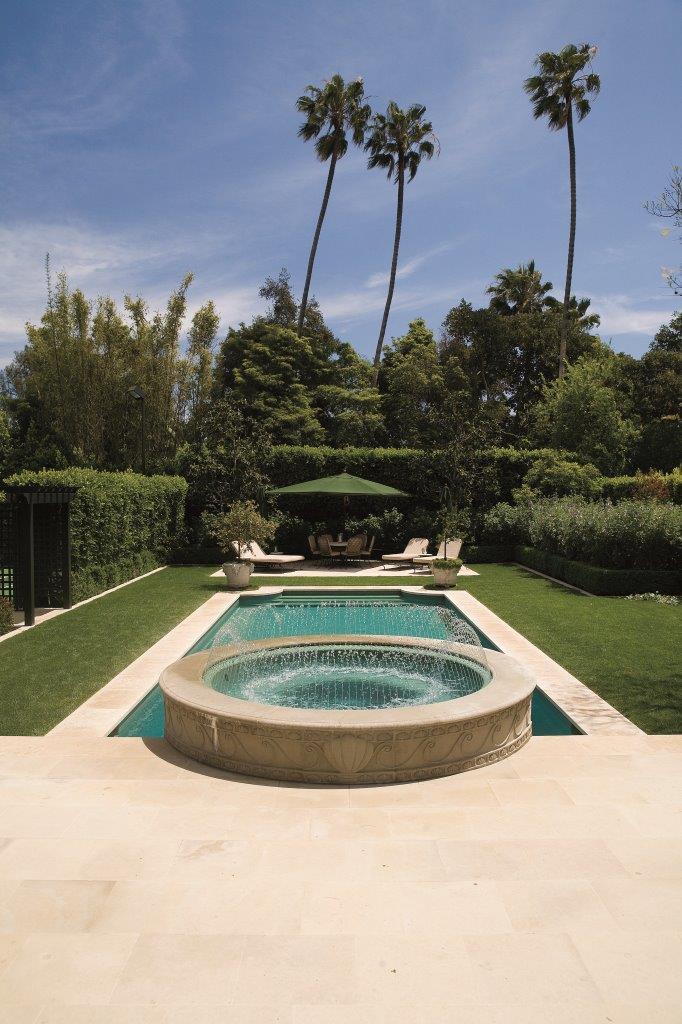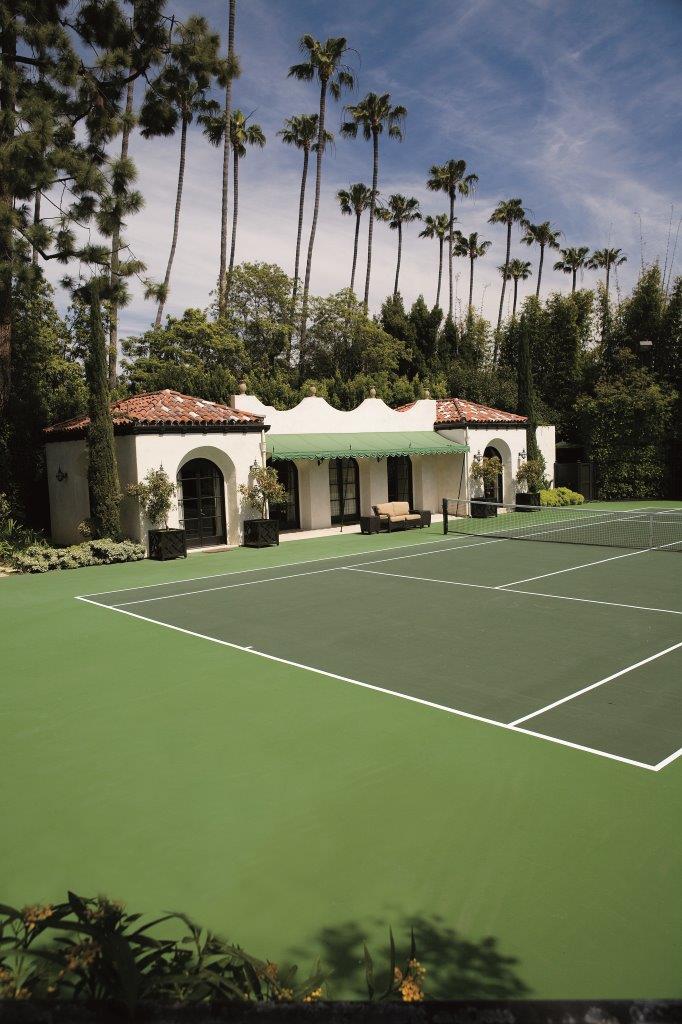
Photo Credit: Randolph Harrison
When Buster Keaton showed guests around his grand Spanish-style mansion on a three-and-one-half-acre estate a block behind the Beverly Hills Hotel, he sometimes joked, “I took a lot of pratfalls to build that dump.”
The twenty-room mansion was hardly a dump; it was one of the finest homes of the 1920s film stars. But Keaton wasn’t kidding about taking a lot of pratfalls. Despite his on-screen brilliance, Keaton’s personal life and his film career were filled with hard times and sorrows.
Joseph Hallie Keaton and his wife Myra—who performed a medicine show and vaudeville act of acrobatics, comedy, and music—were playing in Piqua, Kansas, when first child Joseph Frank Keaton was born on October 4, 1895. He appeared onstage with his parents the next day. When the three-year-old took a tremendous tumble down a flight of stairs and got up unharmed, famed magician and escape artist Harry Houdini, a friend and the child’s godfather said, “What a buster your kid took!” (The word buster meant a dangerous fall.)
That’s how Buster Keaton got his name, and the world got the third brilliant member of its silent-screen Comedic Triumvirate: Charlie Chaplin, Harold Lloyd, and Buster Keaton.

Buster Keaton at his home. Photo Credit: Bison Archives
In May 1921, Keaton made one of the biggest mistakes of his life: He married actress Natalie Talmadge, second of the three Talmadge sisters and sister-in-law to Joseph Schenck.
Natalie Talmadge Keaton was driven by three needs: to keep up with and even surpass her more famous sisters, to meet what she considered the public’s expectations of her as a fashion icon (to be photographed in the same outfit twice was inconceivable), and to exhibit the lifestyle she thought a Hollywood star (and his wife) deserved.
In 1924, Keaton secretly bought a lot in Beverly Hills. He constructed a Mission-style mansion and furnished it as a surprise for Natalie. He thought she’d be wild with excitement. As always, she disappointed him. When he showed her the house for the first time, she dismissed it as being much too small. It had no servants’ quarters.
Heartbroken, Keaton sold the house to Berenice Mannix, the wife of MGM vice president Eddie Mannix, who loved the home. In December 1924, Keaton purchased a three-and-one-half-acre property on a hillock behind the Beverly Hills Hotel with an entrance on Hartford Way. Cowboy star Tom Mix lived next door. Charlie Chaplin, Rudolph Valentino, Douglas Fairbanks Sr., and Mary Pickford were neighbors.

Photo Credit: Randolph Harrison
Although forgotten now, Gene Verge is listed as the architect; it was Keaton who planned large parts of the house and grounds. (He even designed his own bedroom furniture.) Verge assisted him, along with Keaton’s special-effects man, Fred “Gabe” Gabouri. While primarily Italian Renaissance in style, the white house with its many windows and red-tile roof was an eclectic mix of Mission, Spanish, Italian, and Moorish styles. The house had a central entrance with two major wings extending off at gentle angles to the east and the west. The front door stood beneath a narrow, carved-stone second-floor balcony, and it was surrounded by beautiful white Italian Renaissance carved stonework The arched glass, wrought-iron, and mahogany front door opened into a large, sunlit vestibule with high ceilings, a checkerboard terrazzo tile floor of dusty reds and tans, and a small white Italian fountain with flowers at the base.
On the west side of the vestibule and up a few steps through a broad, arched entry was a living room that opened onto an open-air loggia overlooking the grounds. The central feature of the living room was a spectacular Italian Renaissance carved-stone fireplace that was nearly five feet wide. In the west wing off the living room was the Play Room, which had a pool table and built-in cabinets for the pool cues, card tables, a record player, and a hidden bar. (Many 1920s mansions had such a feature because of Prohibition.)
“We used to have weekend poker parties where a man would win or lose $50,000 in an evening and either way didn’t worry about it,” Keaton recalled years later. “He could always make another picture.”
The Play Room could also be converted quickly into a movie theater—it had a projector and a rollout movie screen—where Keaton could show movies to friends and family and also work on his own in-progress films. On the east side of the vestibule, a few steps led up to a broad, arched entry, beyond which was a breakfast room, conservatory, and the dining room (with its hand-painted, beamed ceiling) that opened onto another open-air loggia. The kitchen and servants’ rooms, including the servants’ dining room, were also in the east wing. A grand staircase rose from the entrance vestibule to a gilded gate, reportedly purchased from a Spanish palace, that granted or barred entrance to the second floor. A long, broad hallway with an intricately designed wrought-iron railing overlooked the ground floor.

Photo Credit: Randolph Harrison
Keaton’s bedroom suite took up the east wing, and it had its own entrance—very helpful when he didn’t want to be seen coming and going from rendezvous with his various mistresses. His wife’s bedroom suite took up the larger west wing, and it included an entire room devoted to her vast wardrobe, a small, mirrored, octagonal dressing room, a pink tiled bathroom with gold-plated fixtures, and a king-sized bed on a raised platform.
The Beverly Hills Nurseries landscaped the estate. The house looked out over a huge lawn and a Roman-bath swimming pool, which had a mosaic-tiled bottom. Keaton spent $14,000 for forty-two towering palm trees that lined the driveway from Hartford Way to the house. The lushly landscaped grounds included a playhouse replica of the mansion for Keaton’s sons, a tennis court, an aviary, and kennels. The grounds even included a mechanized trout stream that Keaton had planned and engineered himself. The stream could be turned on and off with the simple flick of a switch.
Keaton—not surprisingly—loved the estate and was justly proud of it. The mansion was featured in his Parlor, Bedroom and Bath (1931). By the late 1920s and early 1930s, Keaton’s film career was spiraling downward. His films were over budget and making little if any profit. The studios, first United Artists, then MGM, started supervising his films closely, which stifled his creativity. Keaton was miserable, and not surprisingly. Unlike Charlie Chaplin and Harold Lloyd, Keaton had been nearly wiped out financially by the stock market crash in October 1929 and the Depression. Not only was money tight, it was stretched beyond belief. In addition to his own family, Keaton was the sole financial support of his mother, father, sister, brother, and his brother’s family.
But Natalie continued to spend as extravagantly as ever. Keaton began drinking heavily. In 1932, Natalie divorced Keaton, charging him with “acts of cruelty” in a bitter and widely publicized court case. She took his entire fortune. She took the Italian villa. And she took their sons, legally changing their last name to Talmadge—and legally changing her eldest son’s name to James. She refused to allow Keaton to see them for the next nine years.

Buster and Natalie Keaton with their two sons. Photo Credit: Bison Archives
At the same time, MGM fired him. Keaton had to file for bankruptcy. By the mid-1930s, Keaton was sober and working again as a (usually uncredited) comedy coach, writer, and gag man. He worked on At the Circus (1939) and Go West (1940) for the Marx Brothers, on films for Red Skelton, and on musicals such as Gene Kelly and Frank Sinatra’s Take Me Out to the Ball Game (1949).
Despite numerous attempts by reporters, biographers, and others to turn his life into a tragedy, Keaton never saw it that way. “I think I have had the happiest and luckiest of lives,” he said. “Maybe this is because I never expected as much as I got. . . . And when the knocks came I felt it was no surprise. I had always known life was like that, full of uppercuts for the deserving and the undeserving alike.”
And what of the Keaton estate in Beverly Hills?
Natalie Talmadge sold the property in September 1932, two months after her divorce from Keaton, to Mrs. Fanchon Simon, half of Fanchon and Marco, an MGM dance team. In July 1938, John Raymond Owens, a millionaire glass manufacturer from Milwaukee, bought the estate, paying $250,000 in cash and land.
In 1940, Barbara Hutton, the Woolworth heiress known as “Miss Moneybags” and “Poor Little Rich Girl” in the press, leased the house from Owens for a year. She was dating Cary Grant at the time. The publicity-shy couple protected their privacy by meeting at his Santa Monica beach house, or at her rented estate. It was at the estate that Grant threw dinner parties and weekly Sunday gatherings for his friends including Marlene Dietrich, David Niven, Rosalind Russell, and Merle Oberon.
When owner John Raymond Owens died at the end of World War II, his estate’s administrator put the property up for sale. And there it stayed. At that time, 1920s estates, no matter how grand or well-located, had gone out of favor.
Finally, in 1948, Pamela Mason, wife of famed British actor James Mason, saw the Italian villa and fell madly in love with it. James Mason, while an admirer of Buster Keaton, was not enamored of the then-high $250,000 asking price and the money the estate would need for its upkeep. But he pushed down the asking price, way down. They bought the property in January 1949 for just $82,000.
- Photo Credit: Randolph Harrison
- Photo Credit: Randolph Harrison
Unfortunately, the Masons made major changes to the estate. Pamela wanted the house to be comfortable and convenient for her two children. She removed the fountain in the vestibule and replaced it with a merry-go-round. She covered the marble and oak wood floors with cork. When she started broadcasting her radio show from the house, she added acoustical tiles to the living room ceiling.
“I’ve made the house comfy,” said Pamela. “It was very beautiful. It’s no longer very beautiful, but it’s very cozy.” When Buster Keaton asked permission to show his wife, Eleanor, the house, Pamela refused. She feared, she said, that the changes she had made to the interior would break his heart. She was probably right.
The Masons also subdivided the estate by selling off much of the property as three lots for new homes. The new cul-de-sac off Hartford Way, which provided access to the houses as well as the new entrance to the estate, was named Pamela Drive in her honor.
Although Pamela Mason altered the mansion, she is the reason Buster Keaton’s home still stands today. After twenty-three years of marriage, Pamela divorced James Mason, accusing him of “habitual adultery,” in 1964. They each got about $1 million in community property. She got everything in the United States, while he kept all their property abroad. So Pamela got from the divorce settlement what she wanted most: her children and the villa. And she held onto both.
Over the years, Pamela hosted numerous glittering parties at the villa, which were attended by that era’s celebrities: Elizabeth Taylor, Groucho Marx, and Vincente Minnelli, as well as rock stars who knew her college-age children. Pamela also let the house be filmed for The Godfather (1972).
Even with all the partying and moviemaking, Pamela made no substantive changes to the estate. She also didn’t maintain it. When something broke or fell into disrepair, she just closed the door and didn’t use that part of the house. When Pamela died in 1996, her daughter inherited the estate. Three years later, she sold the property to two investors who made extensive repairs to the estate.
In 2002, new owners purchased the Keaton estate, and they carried out significant additional work, reclaiming much of the original beauty that had been lost in the previous decades.


